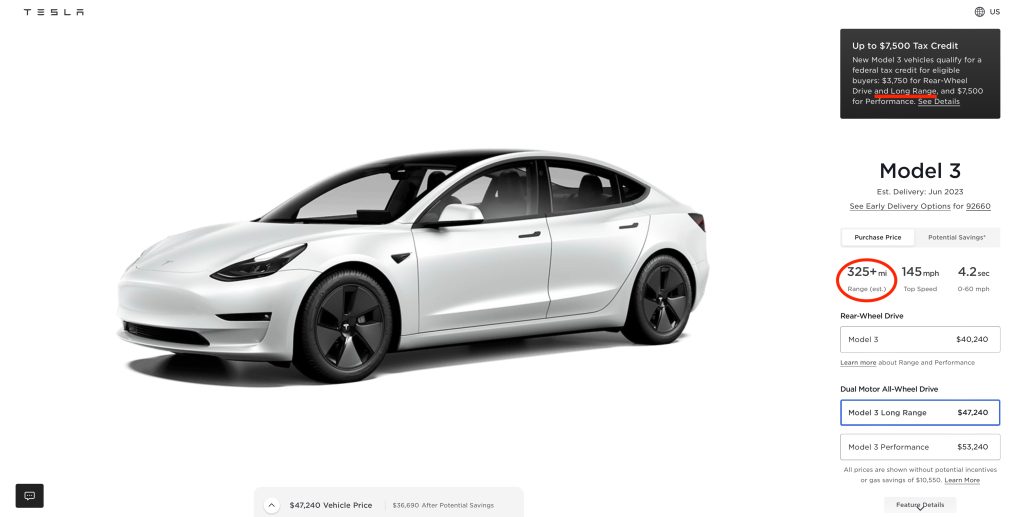
Tesla has once again started taking orders on the Model 3 Long Range in the US, after it was missing for nearly nine months. And it might be using Lithium-iron-phosphate (LiFePO4/LFP) battery cells, like the Model 3 Standard Range, or it might be a new chemistry, based off of LFP…
The changes appeared on Tesla’s website tonight, in Tesla’s Model 3 design studio.
The car has once again appeared, after saying it would be “available in 2023” since last August.
But there are changes that suggest the car might be using Tesla’s LFP pack, which is used in Chinese-built Model 3 and in the Model 3 Standard Range.
First, the car is now listed as having “325+” miles of range, as compared to the previous 358 miles. LFP is a cheaper, less energy-dense technology, so it would make sense that a pack might have less energy in it, and less range as a result.

Second, the car is now listed as receiving only $3,750 of the US EV tax credit, like the Standard Range.
This is due to the way the Inflation Reduction Act tax credits are structured. To qualify, a car must be assembled in North America, but also must source 40% of its critical minerals from the US or free trade countries, and 50% of its battery components must be built in North America. These percentages will go up year by year, but they’re set at those levels for now.
Since the Model 3 Standard Range only qualifies for one of these two categories, it only gets half the credit. This is because it gets its LFP batteries from CATL, a Chinese battery supplier. The same goes for the new Long Range, and so we suspect it’s using the same battery supplier.

So between these two new pieces of information, it looks like Tesla might have introduced a new battery chemistry on the Long Range Model 3 today.
LFP batteries have some interesting pluses and minuses. As mentioned above, they are less energy dense but cheaper, but they also require no cobalt, which is a difficult mineral to get a hold of and carries some human rights baggage. They suffer from less degradation as well, which means your battery will stay healthier longer, though they do worse in very cold environments (so make double sure you precondition your batteries, folks).
Which brings up another note… in the “feature details” section of the page, it says this:

Which, given the worse very cold weather performance of LFPs, maybe suggests that this isn’t LFP after all.
But we also know that CATL has a more energy-dense version of LFP coming this year, which adds manganese into the mix (“LMFP”), so it could be that.
Whatever these batteries are, this new model does create a pricing dilemma (or perhaps an intentional product pricing ladder) for buyers, because while the Long Range and Performance differ in upfront price by $6,000, the post-incentive pricing is only $2,250 more for the Performance. That’s a pretty small premium for more performance, particularly including the other upgrades.
We can see reasons that people might pick the Long Range still – preference for the (possible) LFP batteries, no interest in performance upgrades, preference for the aero wheels (and associated slightly longer range) over the big 20″ performance wheels, and the $2,250 savings of course – but we could see a lot of people making the upgrade now that the price differential is smaller.
And with the additional $3,750 of US federal tax credit, the Long Range Model Y is tantalizingly close to cost parity with this Model 3, making its pricing slightly dubious.
The new Model 3 Long Range is available for orders now, with deliveries starting in June – just one month from now.
This may not be the Model 3 refresh we were waiting for (codenamed “Highland”), but it’s definitely interesting to see more of CATL’s (possibly LFP?) cells in US-market Teslas.
Author: Jameson Dow
Source: Electrek




Top comment by FC
Liked by 8 people
Tesla could drop the LR AWD completely if they just offered the Performance with a set of 18” wheels and tires, even if it was a no-cost option. Tesla had refused to modify the wheel design of the 18” aero wheels to fit the Performance 3’s hub centering ring, so the only options that fit were aftermarket, at least that’s how it was back in 2019-2021. I haven’t kept track since selling my 3P… The range hit the P suffers would disappear completely. In fact, due to the slightly lower ride height, it might be more efficient slightly than the LR AWD due to lower drag. I put a set of T-Sportline 18” wheels and Michelin MXM4 T1 tires on my old 3P and efficiency improved by 20% over the 20s/PS4S tires, even slightly beating the LR AWD on 18” wheels my ex had at the time. Consumption dropped from 310wh/mi at 78mph to about 260wh/mi, while around town I would routinely see efficiency in the low 200s. Ride quality also improved, as did handling from the 10lbs/wheel reduction in unsprung mass at each corner. Of course outright grip wasn’t as great going from PS4S to MXM4, but seeing how most of miles were on the interstate and not a track, I was still fine with the way the car drove.
View all comments